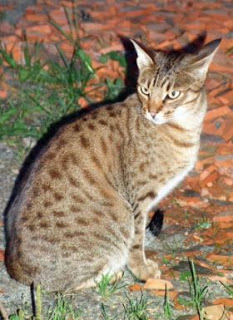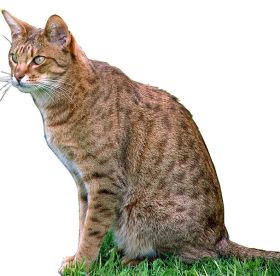Dogs

By Julia Williams
I vividly recall the first time I saw an Ocicat many years ago. I was at a cat show, and we were making the rounds looking at all of the different breeds. I stared at this exquisite spotted cat, certain that it wasn’t a domestic breed but rather, a jungle cat like those I’d seen at a wildlife park. Indeed, the aptly named Ocicat does resemble the ocelot, a wild “big cat” that is currently on the endangered species list. The similarities end there, however, as the domestic Ocicat’s temperament is anything but ferocious.
The French writer Fernand Méry, who penned several books about cats, is quoted as saying “God made the cat in order that humankind might have the pleasure of caressing the tiger.” Indeed, what cat fancier hasn’t entertained thoughts of peacefully co-existing among jungle cats in the wild? The tame-at-heart Ocicat allows us a taste of the exotic without the danger and unpredictable nature of a wild cat. For those who love domestic cats that look wild but will happily curl up on your lap, the beautiful Ocicat is a perfect choice. Had I not been owned by several garden-variety cats, I might well have taken an Ocicat home that day.
History of the Ocicat
The Ocicat is a fairly recent breed of domestic cat. The first Ocicat, a male named Tonga, was born in Berkeley, Michigan in 1964. While trying to produce a Siamese cat with Abyssinian markings, noted CFA breeder Virginia Daly accidentally produced an ivory kitten with golden spots. Upon seeing this unusual “ocelot look-alike,” Mrs. Daly’s daughter suggested they name the spotted kitten an Ocicat, and a new breed was born.
Other breeders soon took on the challenge of refining the breed, mating Ocicats with American Shorthairs. The Ocicat is the only spotted domestic breed of cat selectively bred to emulate its spotted feline cousins in the wild. The Ocicat was recognized for CFA registration in 1966 and was advanced to championship status in 1987. Today, Ocicats are frequently seen at cat shows in the U.S., and some have been exported to other countries where their popularity is steadily rising.
Appearance of the Ocicat
The Ocicat is a medium to large size feline with long legs and an athletic appearance: well muscled and broad chested, yet lithe and graceful. It has a wedge-shaped face with almond-shaped eyes, a short nose, and widely spaced ears that are sometimes tufted. Ocicats have the tabby “M” marking on their forehead, mascara markings around the eyes and on their cheeks, and rows of round spots that run along the spine from their shoulder blade to their tail. Spots are also scattered across their shoulders and hindquarters, extending down the legs.
The Ocicat’s short coat has a glossy sheen that beautifully shows off its spots and muscles. There are twelve accepted Ocicat colors: tawny, chocolate, cinnamon, blue, lavender, fawn, silver, chocolate silver, cinnamon silver, blue silver, lavender silver, and fawn silver.
Personality of the Ocicat
The Ocicat is a confident, playful, active and affectionate breed that loves human company, so much so that they often follow people from room to room observing them as they go about their daily routine. Most are not afraid of new experiences and are quite extroverted around strangers. They also usually get along with children, dogs and other cats. Because of their sociable nature, Ocicats do better in a household where they are not left alone for extended periods.
The Ocicat is a very intelligent breed that is easily trained. Some have even learned how to open doors and perform characteristically “dog-like” behaviors like fetching and walking on a leash. The Ocicat’s mellow nature, coupled with the ability to easily adapt to changes in their environment, make them a wonderful show cat and fine travel companion. There are no genetic health problems associated with the Ocicat breed.
If you love the “jungle cat look” but want a laid-back, friendly feline, the Ocicat is the perfect breed for you. I know I am smitten by them, and if I ever do decide to get a purebred, the Ocicat is high on my list.
Read more articles by Julia Williams
- Cat Breed Profile: The Wild-at-heart Chausie
By Julia Williams People who like cats with a wild look are naturally drawn to the Chausie, an exotic feline with Jungle Cat ancestry. With their long legs, long, lean body and statuesque appearance, Chausie cats are exquisitely beautiful creatures. However,...
- The Sand Cat, A Small But Fierce Desert Wild Cat
By Julia Williams The sand cat might just be the cutest of all wild cats, and it’s also one of the smallest. Don’t let that sweet face and tiny body fool you, though – this desert wild cat is tough as nails! Well yeah…it would have to be, to survive...
- Egyptian Mau Cats: The Oldest Spotted Breed
By Julia Williams The Egyptian word for cat is Mau (rhymes with wow). A translation from the Egyptian Book of the Dead (240 B.C.) states that “The male cat is Ra himself, and he is called by reason of the speech of the god Sa, who said concerning him,...
- A “coat” Of Many Colors…
Tabby, Calico, Gray – okay, well gray is kind of easy, but you get the idea. What kinds of colors are available for cats? And how do you know what you have? We have the answers for you.Interesting FactTri colored cats are almost always female. About...
- The Most Beautiful Spotted Breeds Of Cat
Some cat breeds are hairless while others are shorthaired. There are also longhaired and curly breeds. If there are striped cat breeds there are also spotted cat breeds. Here they are the prettiest spotted breed of domestic cats… 1.) Manx Image Source ...
Dogs
Ocicats May Look Wild, But They’re Tame at Heart

By Julia Williams
I vividly recall the first time I saw an Ocicat many years ago. I was at a cat show, and we were making the rounds looking at all of the different breeds. I stared at this exquisite spotted cat, certain that it wasn’t a domestic breed but rather, a jungle cat like those I’d seen at a wildlife park. Indeed, the aptly named Ocicat does resemble the ocelot, a wild “big cat” that is currently on the endangered species list. The similarities end there, however, as the domestic Ocicat’s temperament is anything but ferocious.
The French writer Fernand Méry, who penned several books about cats, is quoted as saying “God made the cat in order that humankind might have the pleasure of caressing the tiger.” Indeed, what cat fancier hasn’t entertained thoughts of peacefully co-existing among jungle cats in the wild? The tame-at-heart Ocicat allows us a taste of the exotic without the danger and unpredictable nature of a wild cat. For those who love domestic cats that look wild but will happily curl up on your lap, the beautiful Ocicat is a perfect choice. Had I not been owned by several garden-variety cats, I might well have taken an Ocicat home that day.
History of the Ocicat
The Ocicat is a fairly recent breed of domestic cat. The first Ocicat, a male named Tonga, was born in Berkeley, Michigan in 1964. While trying to produce a Siamese cat with Abyssinian markings, noted CFA breeder Virginia Daly accidentally produced an ivory kitten with golden spots. Upon seeing this unusual “ocelot look-alike,” Mrs. Daly’s daughter suggested they name the spotted kitten an Ocicat, and a new breed was born.
Other breeders soon took on the challenge of refining the breed, mating Ocicats with American Shorthairs. The Ocicat is the only spotted domestic breed of cat selectively bred to emulate its spotted feline cousins in the wild. The Ocicat was recognized for CFA registration in 1966 and was advanced to championship status in 1987. Today, Ocicats are frequently seen at cat shows in the U.S., and some have been exported to other countries where their popularity is steadily rising.

Appearance of the Ocicat
The Ocicat is a medium to large size feline with long legs and an athletic appearance: well muscled and broad chested, yet lithe and graceful. It has a wedge-shaped face with almond-shaped eyes, a short nose, and widely spaced ears that are sometimes tufted. Ocicats have the tabby “M” marking on their forehead, mascara markings around the eyes and on their cheeks, and rows of round spots that run along the spine from their shoulder blade to their tail. Spots are also scattered across their shoulders and hindquarters, extending down the legs.
The Ocicat’s short coat has a glossy sheen that beautifully shows off its spots and muscles. There are twelve accepted Ocicat colors: tawny, chocolate, cinnamon, blue, lavender, fawn, silver, chocolate silver, cinnamon silver, blue silver, lavender silver, and fawn silver.
Personality of the Ocicat
The Ocicat is a confident, playful, active and affectionate breed that loves human company, so much so that they often follow people from room to room observing them as they go about their daily routine. Most are not afraid of new experiences and are quite extroverted around strangers. They also usually get along with children, dogs and other cats. Because of their sociable nature, Ocicats do better in a household where they are not left alone for extended periods.
The Ocicat is a very intelligent breed that is easily trained. Some have even learned how to open doors and perform characteristically “dog-like” behaviors like fetching and walking on a leash. The Ocicat’s mellow nature, coupled with the ability to easily adapt to changes in their environment, make them a wonderful show cat and fine travel companion. There are no genetic health problems associated with the Ocicat breed.
If you love the “jungle cat look” but want a laid-back, friendly feline, the Ocicat is the perfect breed for you. I know I am smitten by them, and if I ever do decide to get a purebred, the Ocicat is high on my list.
Read more articles by Julia Williams
- Cat Breed Profile: The Wild-at-heart Chausie
By Julia Williams People who like cats with a wild look are naturally drawn to the Chausie, an exotic feline with Jungle Cat ancestry. With their long legs, long, lean body and statuesque appearance, Chausie cats are exquisitely beautiful creatures. However,...
- The Sand Cat, A Small But Fierce Desert Wild Cat
By Julia Williams The sand cat might just be the cutest of all wild cats, and it’s also one of the smallest. Don’t let that sweet face and tiny body fool you, though – this desert wild cat is tough as nails! Well yeah…it would have to be, to survive...
- Egyptian Mau Cats: The Oldest Spotted Breed
By Julia Williams The Egyptian word for cat is Mau (rhymes with wow). A translation from the Egyptian Book of the Dead (240 B.C.) states that “The male cat is Ra himself, and he is called by reason of the speech of the god Sa, who said concerning him,...
- A “coat” Of Many Colors…
Tabby, Calico, Gray – okay, well gray is kind of easy, but you get the idea. What kinds of colors are available for cats? And how do you know what you have? We have the answers for you.Interesting FactTri colored cats are almost always female. About...
- The Most Beautiful Spotted Breeds Of Cat
Some cat breeds are hairless while others are shorthaired. There are also longhaired and curly breeds. If there are striped cat breeds there are also spotted cat breeds. Here they are the prettiest spotted breed of domestic cats… 1.) Manx Image Source ...
